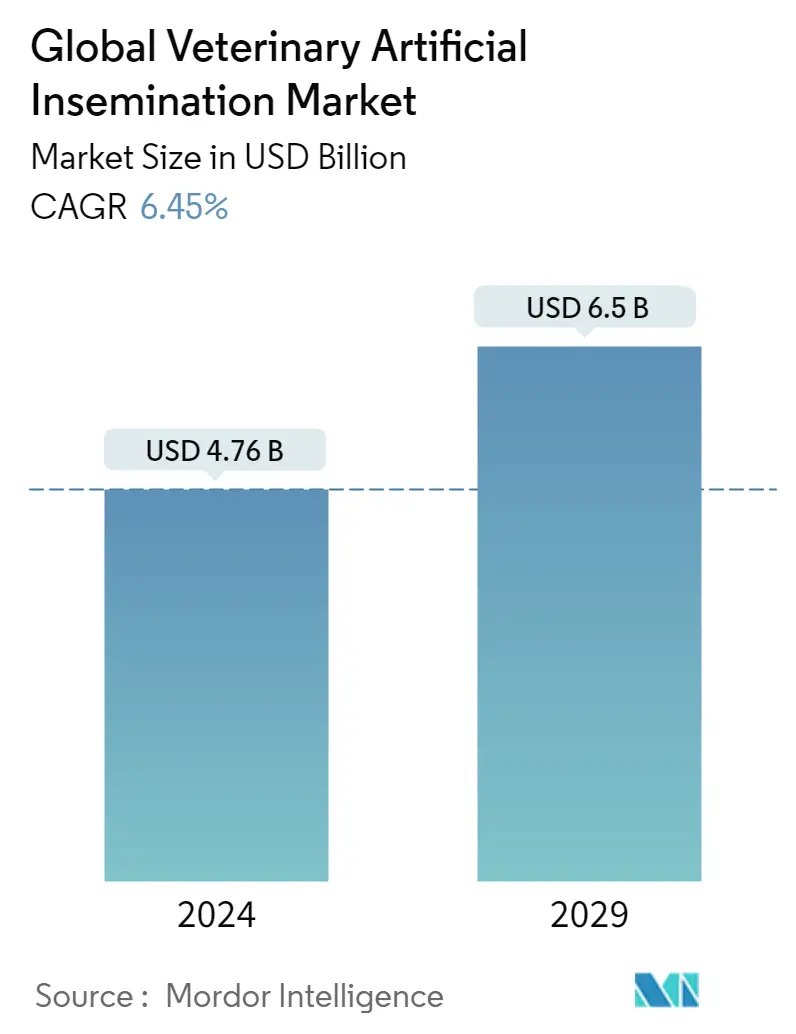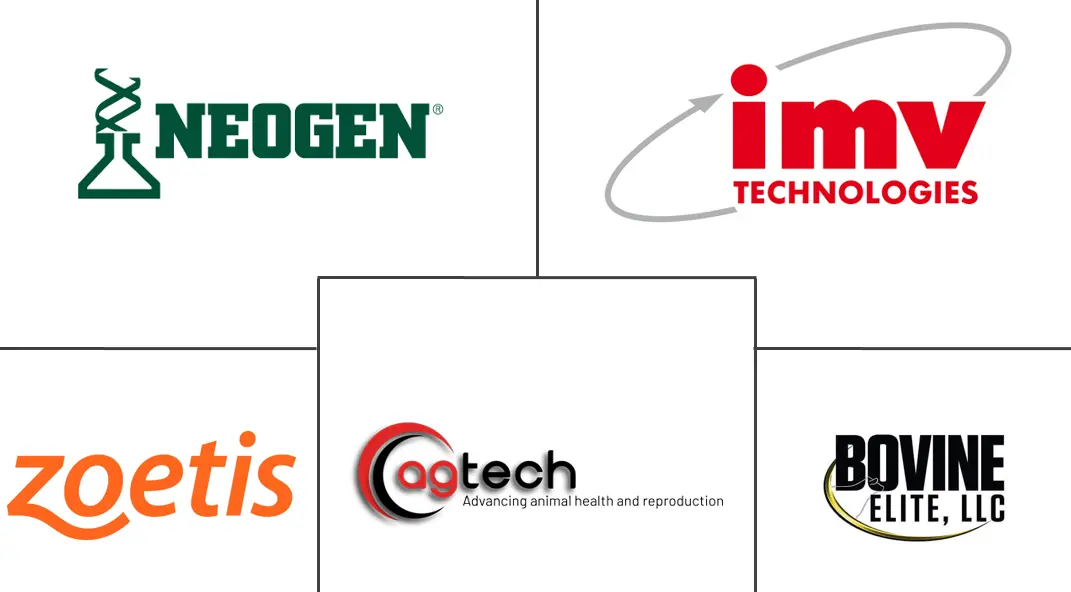Market Size of Global Veterinary Artificial Insemination Industry

| Study Period | 2019 - 2029 |
| Market Size (2024) | USD 4.76 Billion |
| Market Size (2029) | USD 6.50 Billion |
| CAGR (2024 - 2029) | 6.45 % |
| Fastest Growing Market | Asia Pacific |
| Largest Market | North America |
Major Players
*Disclaimer: Major Players sorted in no particular order |
Veterinary Artificial Insemination Market Analysis
The Global Veterinary Artificial Insemination Market size is estimated at USD 4.76 billion in 2024, and is expected to reach USD 6.5 billion by 2029, growing at a CAGR of 6.45% during the forecast period (2024-2029).
The COVID-19 pandemic has created a significant adverse impact on different sectors, including the veterinary sectors in several countries. It has caused disruptions in livestock and poultry value chains, leading to a fall in the procurement and sale of animal-sourced food. Animals suffered due to a lack of adequate feed and veterinary care, such as the need for timely artificial insemination, timely pregnancy check, and de-worming. To safeguard farmers and employees against COVID-19, the Animal Husbandry Department of India launched a program in June 2020, which offered telephonic assistance to poultry farmers and owners. Additionally, artificial insemination was delivered to farmers at their doorstep during the COVID-19 pandemic. Therefore, such initiatives have contributed to market growth.
The factors driving the market growth include the growing animal and fishery industry and the increasing burden of sexually transmitted diseases. As per an article titled 'Controlling sexually transmitted diseases in cattle' published in March 2022, sexually transmitted diseases (STDs), such as vibriosis and bovine trichomoniasis (trich), can become a major problem and result in substantial production losses. Hence, protecting farm animals from the spread of sexually transmitted diseases is expected to drive the market. Furthermore, globally, the demand for the superior breed of animals is increasing, which, in turn, is increasing the demand for artificial insemination procedures in animals. Additionally, globally, the rising human population and associated advantages, such as decreased cost of housing, increased efficiency of bull usage, safety for farmers and animals, genetic selection, and handling of bulls, are anticipated to drive market growth in the future.
The artificial insemination technique helps reduce many of the transmitted diseases among veterinary animals. It allows greater efficiency in terms of genetics and crossbreeding of animals. As per an article titled 'Success rate of artificial insemination, reproductive performance and economic impact of the failure of first service insemination: a retrospective study' published in June 2022, artificial insemination (AI) is recognized as the best technique for increasing reproductive capacity and has received a widespread application in farm animals in Ethiopia. The success of AI is also influenced by endometrial thickness, artifcial insemination timing, insemination frequency, and ovarian stimulation protocols. This is expected to increase the demand for artificial insemination (AI) and drive market growth in the forecast period.
Furthermore, as per the Food and Agriculture Organization of the United Nations, October 2021, approximately 50% of the world's population consumes fish as food, which is driving the need for larger production of animals. Therefore, this is expected to boost the demand for veterinary artificial insemination.
However, the high cost of equipment and procedures is expected to restrain the market growth during the forecast period.
Veterinary Artificial Insemination Industry Segmentation
As per the scope of the report, artificial insemination is a technique of breeding animals through frozen straws with the help of various equipment and reagents. The veterinary artificial insemination market is segmented by product type (equipment, reagents and kits, and other product types), end user (veterinary hospitals, veterinary clinics, and other end users), and geography (North America, Europe, Asia Pacific, Middle East and Africa, and South America). The report offers the value (in USD million) for the above segments.
| By Product Type | |
| Equipment | |
| Reagents and Kits | |
| Other Product Types |
| By End User | |
| Veterinary Hospitals | |
| Veterinary Clinics | |
| Other End Users |
| By Geography | ||||||||
| ||||||||
| ||||||||
| ||||||||
| ||||||||
|
Global Veterinary Artificial Insemination Market Size Summary
The veterinary artificial insemination market is poised for significant growth, driven by the increasing demand for superior animal breeds and the need to combat sexually transmitted diseases in livestock. The technique offers numerous advantages, including enhanced genetic selection, improved crossbreeding efficiency, and reduced disease transmission among animals. The COVID-19 pandemic, while initially disrupting the market, has led to innovative solutions such as telephonic assistance and doorstep services for artificial insemination, which have contributed to market expansion. The rising global population and the growing fishery industry further bolster the demand for artificial insemination, as it supports larger animal production and ensures food security.
In the Asia-Pacific region, the market is experiencing robust growth due to heightened awareness of artificial insemination and the prevalence of infectious diseases in animals. Countries like India, China, and South Korea are at the forefront, implementing initiatives to educate farmers and enhance breeding management during the pandemic. The adoption of advanced technologies, such as sexed semen, is also gaining traction, particularly in India, where it aims to improve cattle productivity by controlling the sex ratio of calves. Despite the high costs associated with artificial insemination procedures, the market remains competitive, with both international and local companies actively participating in the sector.
Global Veterinary Artificial Insemination Market Size - Table of Contents
-
1. MARKET DYNAMICS
-
1.1 Market Overview
-
1.2 Market Drivers
-
1.2.1 Growing Animal Husbandry and Fishery Industry
-
1.2.2 Increasing Burden of Venereal Diseases in Animals
-
-
1.3 Market Restraints
-
1.3.1 High Cost of Equipment
-
-
1.4 Industry Attractiveness - Porter's Five Forces Analysis
-
1.4.1 Bargaining Power of Buyers/Consumers
-
1.4.2 Bargaining Power of Suppliers
-
1.4.3 Threat of New Entrants
-
1.4.4 Threat of Substitute Products
-
1.4.5 Intensity of Competitive Rivalry
-
-
-
2. MARKET SEGMENTATION
-
2.1 By Product Type
-
2.1.1 Equipment
-
2.1.2 Reagents and Kits
-
2.1.3 Other Product Types
-
-
2.2 By End User
-
2.2.1 Veterinary Hospitals
-
2.2.2 Veterinary Clinics
-
2.2.3 Other End Users
-
-
2.3 By Geography
-
2.3.1 North America
-
2.3.1.1 United States
-
2.3.1.2 Canada
-
2.3.1.3 Mexico
-
-
2.3.2 Europe
-
2.3.2.1 Germany
-
2.3.2.2 United Kingdom
-
2.3.2.3 France
-
2.3.2.4 Italy
-
2.3.2.5 Spain
-
2.3.2.6 Rest of Europe
-
-
2.3.3 Asia Pacific
-
2.3.3.1 China
-
2.3.3.2 Japan
-
2.3.3.3 India
-
2.3.3.4 Australia
-
2.3.3.5 South Korea
-
2.3.3.6 Rest of Asia Pacific
-
-
2.3.4 Middle-East and Africa
-
2.3.4.1 GCC
-
2.3.4.2 South Africa
-
2.3.4.3 Rest of Middle-East and Africa
-
-
2.3.5 South America
-
2.3.5.1 Brazil
-
2.3.5.2 Argentina
-
2.3.5.3 Rest of South America
-
-
-
Global Veterinary Artificial Insemination Market Size FAQs
How big is the Global Veterinary Artificial Insemination Market?
The Global Veterinary Artificial Insemination Market size is expected to reach USD 4.76 billion in 2024 and grow at a CAGR of 6.45% to reach USD 6.50 billion by 2029.
What is the current Global Veterinary Artificial Insemination Market size?
In 2024, the Global Veterinary Artificial Insemination Market size is expected to reach USD 4.76 billion.

